Cookbook #227: Mastering the Art of French Cooking, Julia Child, Louisette Bertholle, Simone Beck, Borzoi Books, Alfred A. Knopf, NY, 1961. Thirtieth Printing, June, 1978.

“Julie & Julia”, the 2009 film starring Meryl Streep and Amy Adams, portrays the true story of Julie Powell, a young New Yorker who took on the challenge of cooking all 524 recipes in Mastering the Art of French Cooking. She covered her experiences in a blog, and eventually a book: Julie and Julia: 365 Days, 524 Recipes, 1 Tiny Apartment Kitchen. When the movie came out, I ran upstairs to see if I had a copy of Mastering the Art of French Cooking. And yes, it was on my bookshelf!
Mastering the Art of French Cooking always intimidated me. My copy is barely wrinkled, no food stains mar the pages. In the past, no more did I want to read it that I would want to read a book on advanced physical chemistry.
I’ve grown up a bit though, and taken a class on classic French sauces. I’ve also learned how to make my own great stocks. I’ll say “I am wiser”, and am feeling this especially this week because I just turned a year older. Now as I turn the pages of Mastering the Art of French Cooking, I can understand the language and appreciate the wisdom, and I smile warmly at Julia Child’s complete love of cooking.
On my birthday this week, I got up late and decided to make an omelet. And I don’t just mean “make an omelet”, I wanted to make an omelet according to Julia’s directions. I wanted nothing else for breakfast! Just an experiment. It was, afterall, my birthday.
I open Mastering the Art of French Cooking to page 127. Julia Child says it will only take 30 seconds to make the omelette. And, “An omelette cannot be made in a sticky pan. The eggs must be able to slide around freely. This is why it is a good idea to have one pan that is reserved for omelettes only.” And the type of pan Julia Child likes the best? The French type of plain iron pan with sloping sides. Aha, I own just such a pan! I got it about a year ago. But I banished it to the basement because it is so heavy and hard to clean.
Today I jog down to the basement and retrieve the pan. I scrub it with steel wool and soap, dry it carefully, and heat it to get all the water off. Then I rub it with oil and wipe all that off. I set it on the stove.
“The individual 2- to 3-egg omelette is usually the tenderest, and by far the best size to practice making.” Perfect. “Just before heating the butter in the pan, break the eggs into a mixiing bowl and add salt and pepper. With a large table fork, beat the eggs only enough to blend the whites and yolks thoroughly. From 30 to 40 vigorous strokes should be sufficient.”
My 3 eggs mixed with 30 vigorous strokes, it’s time to heat my pan. “Place the butter [1 tablespoon] in the pan and set over very high heat . . . as the butter melts, tilt the pan in all directions to film the sides. When you see that the foam has almost subsided in the pan and the butter is on the point of coloring, it is an indication that it is hot enough to pour in the eggs.”
Next comes the short but busy omelette-cooking step. I am to hold the (heavy) pan in my left hand, pour in the eggs, and immediately start sliding the pan back and forth rapidly over the heat. And at the same time, I am supposed to stir the eggs with the bottom flat side of a fork to spread them all over the bottom of the pan. In only 3 or 4 seconds, the eggs will become a light custard, and it will be time to tilt the pan at a 45 degree angle and gather the eggs at the far lip of the pan. And give “4 or 5 sharp blows on the handle of the pan with your right fist to loosen the omelette and make the far edge curl over onto itself.”
This all happened very fast. But somehow, I poured a creamy, soft roll of eggs onto a plate. No toast, no coffee cake, no sausage, just eggs. I immediately take the hot omelette and two forks and sit down next to my husband. He gives me this look, as if, he is supposed to share this with me? “It’s my birthday, I can do what I want!”
I took the first bite and . . . heavenly tastes and textures burst in my mouth. Dang that was a great omelette. Thank you Julia Child!
I spend several days paging through Mastering the Art of French Cooking. I took lots of notes! I really do like this classic cookbook. I suggest every serious cook buy or borrow a copy at some point in their life.
The only drawback to Julia Child’s recipes is the heavy use of butter, cream, and egg yolks. Yes, I have read The Big Fat Surprise, a book that disputes the generally accepted idea that the fats in these foods are bad for you, and instead encourages us to include them in our diet. But still, calories are calories, and stick on my body as weight when I eat too many. Just saying.
But this week, I will indulge in a Julia Child recipe: Filets de Poisson Gratinés, à la Parisienne, or “Fish Filets Poached in White Wine; Cream and Egg Yolk Sauce.” This recipe is a great example of Julia Child’s presentation style.
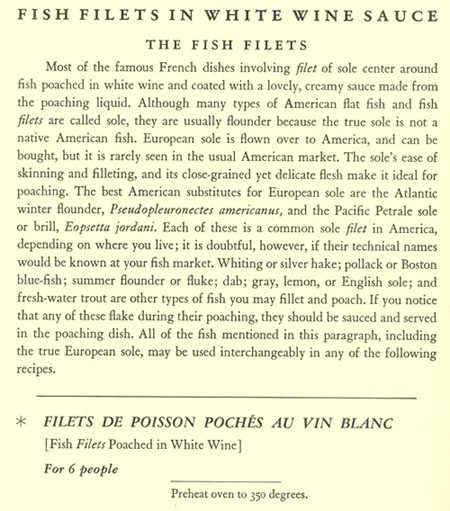
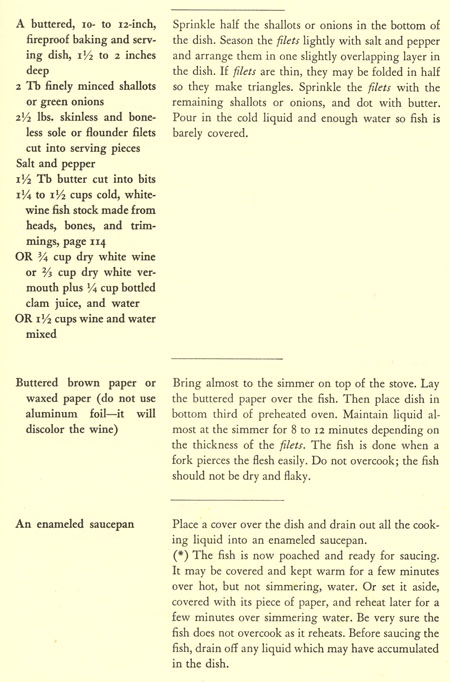

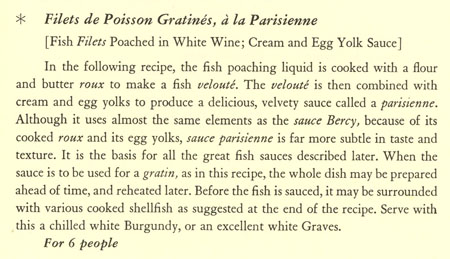

Below is my adaptation of this recipe. Note that you need a baking dish that you can heat on the stove top and also place in the oven. I used a LeCreuset.
Poached Sole in Velouté Sauce
serves 2
Poaching the fish:
- 1 pound sole filets
- 1 tablespoon minced shallots
- butter: you need this throughout; I used unsalted butter, less than a cube in all
- salt and pepper
- 1/2 cup fish stock (or use water)
- 1/2 cup white wine
- a piece of parchment cut to fit the LeCreuset
Turn on the oven to 350˚.
Butter the bottom of a LeCreuset. Sprinkle in half the minced shallots. Season the sole filets with salt and pepper, then place in the prepared LeCreuset, slightly overlapping the filets. Dot with 3/4 tablespoon butter cut into small chunks. Combine the fish stock and the wine and pour over the fish. Add a little more stock if necessary to barely cover the fish. Mine looked like this:
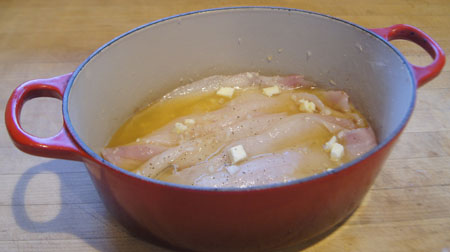
On the stovetop, bring the fish almost to simmering. Butter both sides of the piece of parchment. Place the LeCreuset in the 350˚ oven. Bake for 8 minutes, check for doneness by piercing with a fork (you should find just a slight resistance), and bake a few more minutes only if necessary. During the baking, the cooking liquid should be at a light simmer.
Drain the cooking liquid into a small saucepan, leaving the poached fish in the LeCreuset, covered with the parchment.
Boil the cooking liquid until it is reduced to 1/2 cup. This will be use in the sauce.
Veloute Sauce:
- 1 1/2 tablespoons butter
- 2 tablespoons flour
- 1/2 cup reduced cooking liquid (hot)
- 3/8 cup milk
- 1 egg yolk
- 1/4 cup cream
- “drops” of lemon juice
- 1/2 tablespoon butter
- 1 tablespoon grated Swiss cheese
Melt the 1 1/2 tablespoons butter in a small sauce pan, then add the flour and stir until it is all mixed in. Continue cooking until it thickens but do not cook it until it browns. Off heat, beat in the hot cooking liquid and the milk. A whisk works well for this step. Put the pan back on the stove and bring to a boil, stirring constantly. Boil about a minute – the mixture will be thick.
In a bowl, blend the egg yolk with the cream, using a whisk. Add small amounts of the hot sauce and continue beating until about 1/2 cup of the hot sauce is added, then add the rest of the hot sauce in a thin stream. Put the mixture back in the pan and boil and stir 1 minute. You can thin with a little cream if it is too thick for your tastes. Add a few drops of lemon juice and salt and pepper.
Preheat the broiler.
Spoon the sauce over the poached fish (take the parchment off first), then dot the top with the 1/2 tablespoon butter and the Swiss cheese. On the stove top, over low heat, heat until it is just simmering.
Put the dish under the broiler until the top of the sauce is brown.
What is nice about this dish is that you can assemble it with the poached fish covered with sauce, and then do the stove-top heating and broiling steps just before serving. It’s important to bring this dish to the table hot and bubbly.
Here is the plated dish.
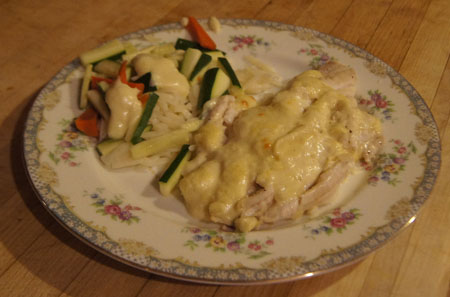 I served with a little orzo and steamed julienned zucchini and carrots on the side. I also served a loaf of my own no-knead bread. And a couple pretty green salads. For dessert? Fresh blackberries over ice cream.
I served with a little orzo and steamed julienned zucchini and carrots on the side. I also served a loaf of my own no-knead bread. And a couple pretty green salads. For dessert? Fresh blackberries over ice cream.
I took my first bite of the fish and then I had to set down my fork so I wouldn’t gobble up the rest too fast. This is absolutely delicious! “One of the best twenty-five meals ever in my life” was my comment.
Thank you Julia Child.

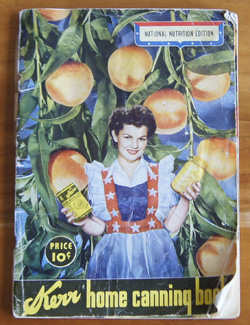 The time is 1943 and World War II is raging when this Kerr Home Canning Book is published. My parents, grandparents, uncles and aunts are affected, whether serving in the armed forces or living in the US. The entire American population gathers together to help the war effort. I wish now that I had had long talks with my parents and grandparents about the war, and learned more about their experiences, their feelings.
The time is 1943 and World War II is raging when this Kerr Home Canning Book is published. My parents, grandparents, uncles and aunts are affected, whether serving in the armed forces or living in the US. The entire American population gathers together to help the war effort. I wish now that I had had long talks with my parents and grandparents about the war, and learned more about their experiences, their feelings.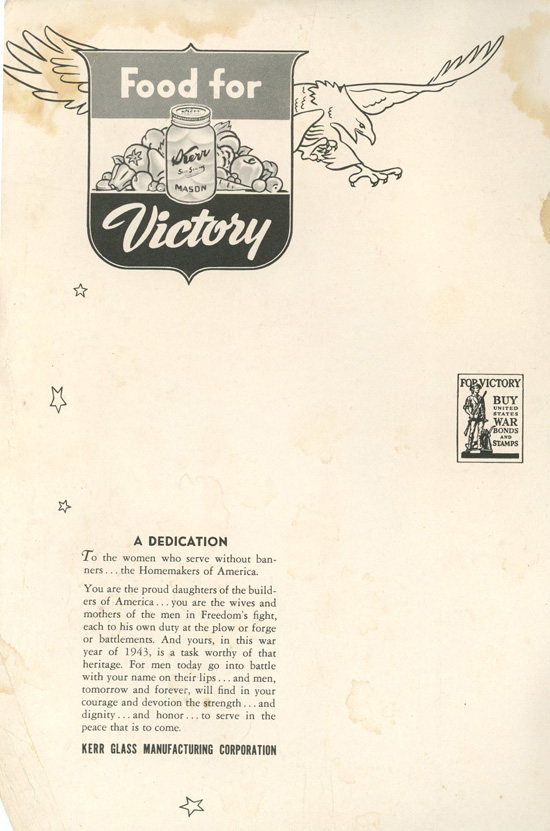
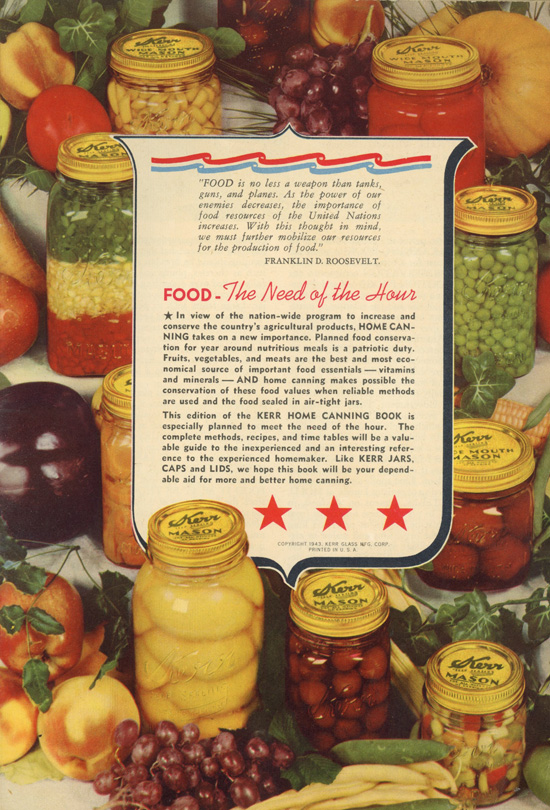
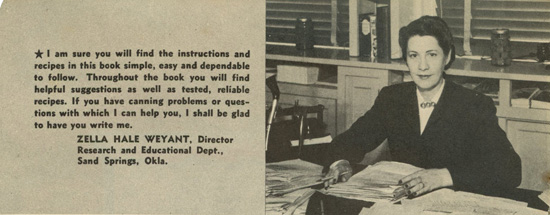
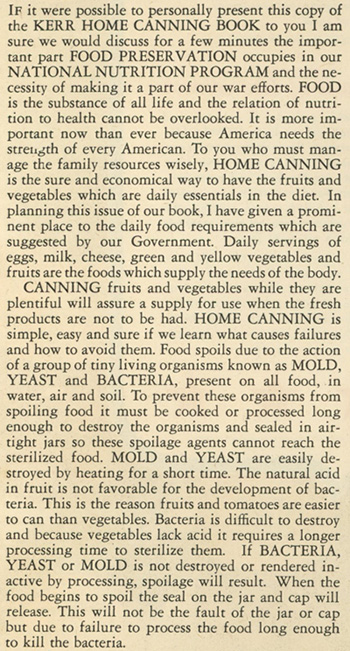 More nostalgia:
More nostalgia:
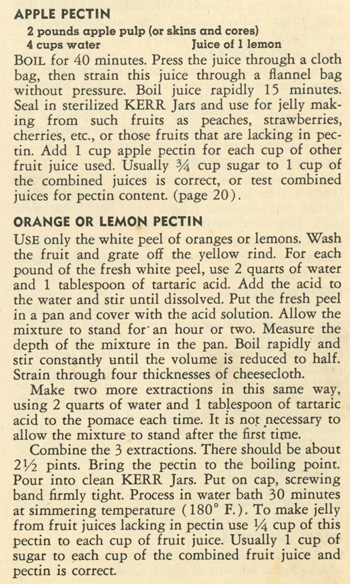
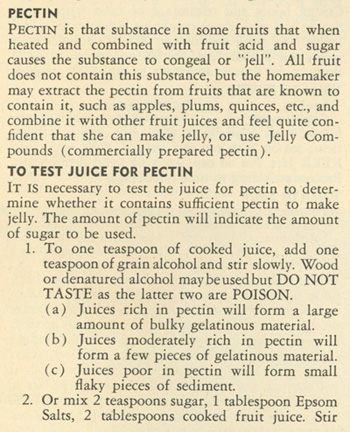
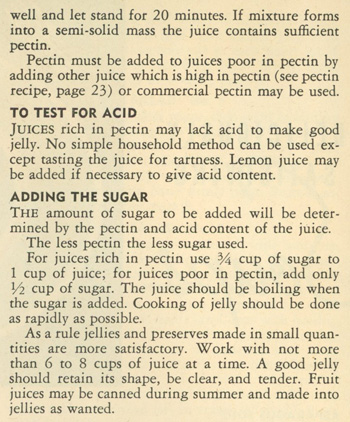 In the above excerpt, they do state that “commercial pectin” can be used, so apparently boxed or bottled pectin was available in 1943. Sure enough, Wikipedia states that pectin was commercially produced by the 1920s.
In the above excerpt, they do state that “commercial pectin” can be used, so apparently boxed or bottled pectin was available in 1943. Sure enough, Wikipedia states that pectin was commercially produced by the 1920s.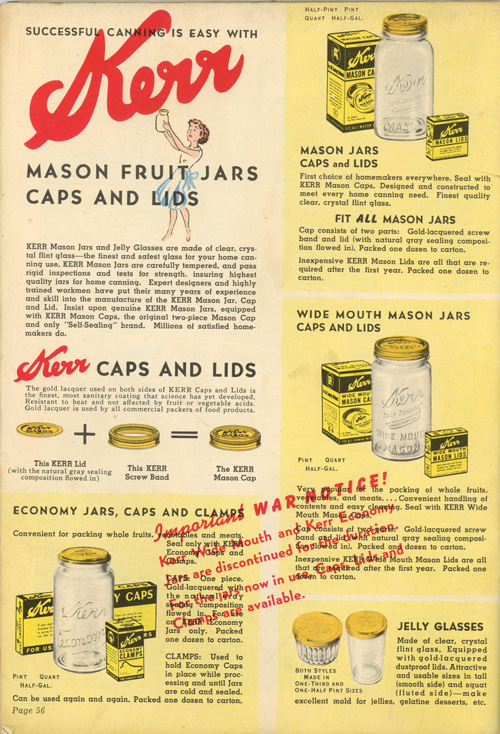


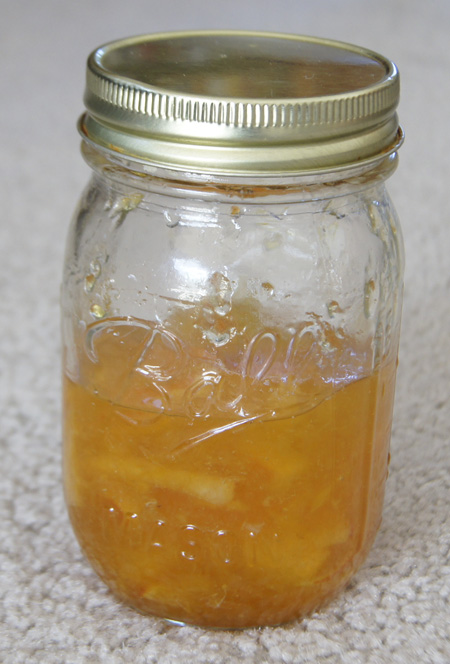

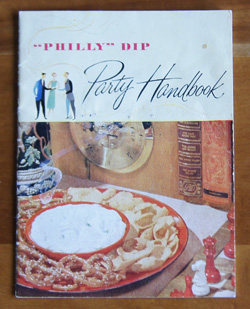 Philly Dip Party Handbook is a paper booklet of cream cheese dip recipes. It’s only 4.5 x 6-inches and 20 pages long. Was it my mother’s? Grandmother’s? I am not sure, as there is no handwriting in this booklet. There is no publication date given, but from web searches, I learned that it was published in the 1950s or 1960s.
Philly Dip Party Handbook is a paper booklet of cream cheese dip recipes. It’s only 4.5 x 6-inches and 20 pages long. Was it my mother’s? Grandmother’s? I am not sure, as there is no handwriting in this booklet. There is no publication date given, but from web searches, I learned that it was published in the 1950s or 1960s.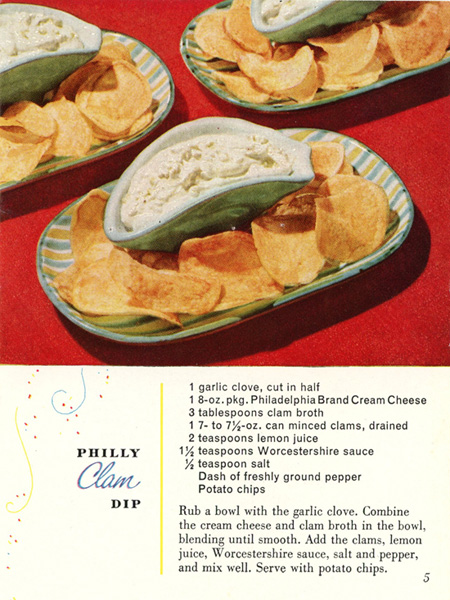
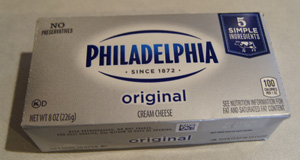 I remember with fondness clam dips from my childhood. Often my father would make it, and he always claimed his was clam dip was the “best clam dip ever”. He might have added sour cream to his version. As for me, I’ll make it just like the recipe in the Philly Dip Party Handbook.
I remember with fondness clam dips from my childhood. Often my father would make it, and he always claimed his was clam dip was the “best clam dip ever”. He might have added sour cream to his version. As for me, I’ll make it just like the recipe in the Philly Dip Party Handbook.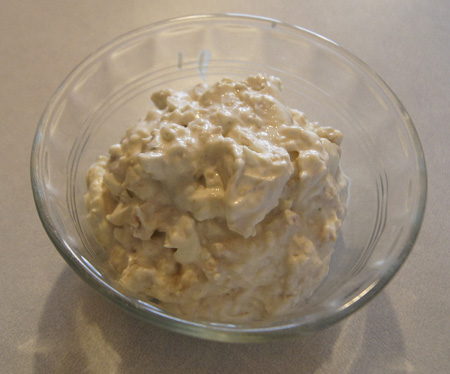
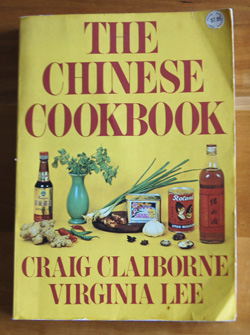 The Chinese Cookbook is one of my favorite cookbooks. I always keep it in my kitchen for ready reference!
The Chinese Cookbook is one of my favorite cookbooks. I always keep it in my kitchen for ready reference! Claiborne goes on to talk about his fourteen year stint as the food news editor and restaurant critic for the New York Times, saying “I was tired. I neeeded rest and a respite from cooking. And then I met Virginia Lee.”
Claiborne goes on to talk about his fourteen year stint as the food news editor and restaurant critic for the New York Times, saying “I was tired. I neeeded rest and a respite from cooking. And then I met Virginia Lee.”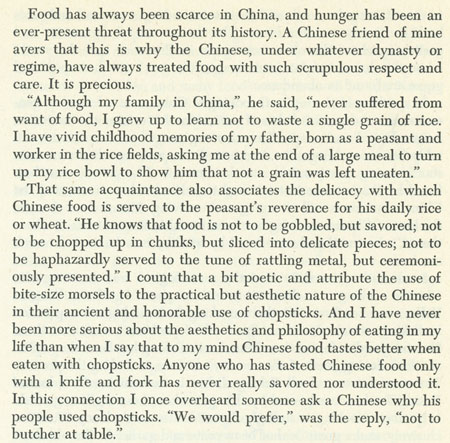 I learned how to make most of my current repertoire of Chinese dishes from The Chinese Cookbook. The recipes are easy to follow, even though the ingredient lists might look daunting with exotic ingredients. For instance, Hot and Sour Soup:
I learned how to make most of my current repertoire of Chinese dishes from The Chinese Cookbook. The recipes are easy to follow, even though the ingredient lists might look daunting with exotic ingredients. For instance, Hot and Sour Soup: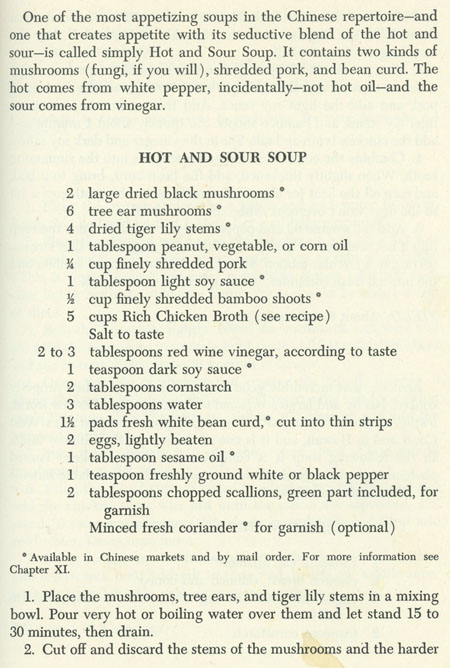
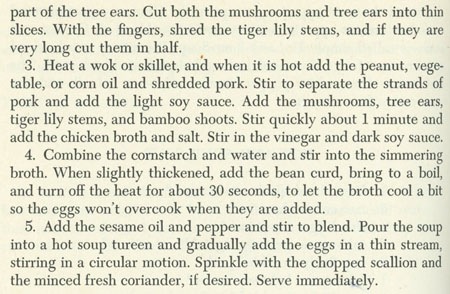 I’ve made this Hot and Sour Soup many times. Dried black mushrooms, tree ear mushrooms, and dried tiger lily stems! Ages ago, I had to go all the way to Denver to a Chinese market to find all of these ingredients. Nowadays I go to the Asian Seafood Market in Boulder. Sometimes I leave out these exotic ingredients, if I have none on hand, or I use fresh shitakes and skip the tree ear and black mushrooms tiger lilies. Not as much fun, but still a good soup.
I’ve made this Hot and Sour Soup many times. Dried black mushrooms, tree ear mushrooms, and dried tiger lily stems! Ages ago, I had to go all the way to Denver to a Chinese market to find all of these ingredients. Nowadays I go to the Asian Seafood Market in Boulder. Sometimes I leave out these exotic ingredients, if I have none on hand, or I use fresh shitakes and skip the tree ear and black mushrooms tiger lilies. Not as much fun, but still a good soup.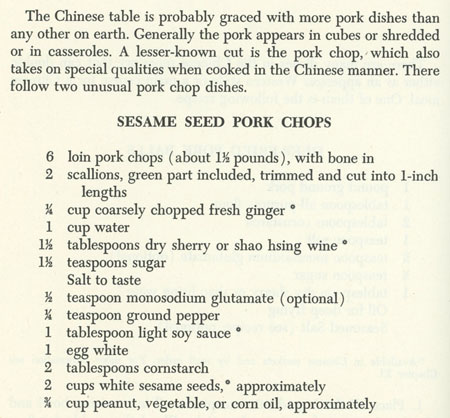
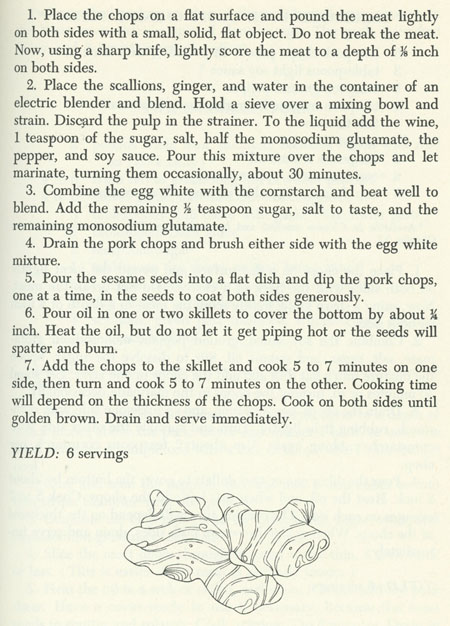 I made these pretty much as per the above recipe, except I left out the monosodium glutamate, and I halved the recipe for two people, but did not halve the amount of egg white/cornstarch mixture. I used bone-in pork sirloin chops, but actually, next time I’d prefer to use boneless pork sirloin.
I made these pretty much as per the above recipe, except I left out the monosodium glutamate, and I halved the recipe for two people, but did not halve the amount of egg white/cornstarch mixture. I used bone-in pork sirloin chops, but actually, next time I’d prefer to use boneless pork sirloin.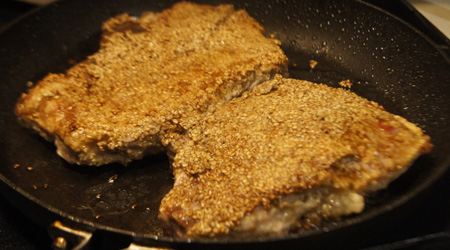 To serve, I sliced the cooked chops into large chunks. It was messy because I had to avoid the bone. But, the pork was very, very juicy and flavorful. I served with fried rice and snow peas and fresh shitakis.
To serve, I sliced the cooked chops into large chunks. It was messy because I had to avoid the bone. But, the pork was very, very juicy and flavorful. I served with fried rice and snow peas and fresh shitakis.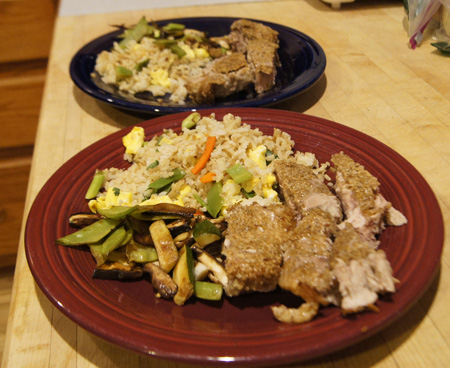
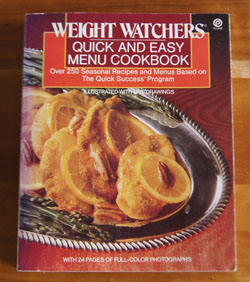 This is the second Weight Watchers book that I have covered in this blog, the other was
This is the second Weight Watchers book that I have covered in this blog, the other was 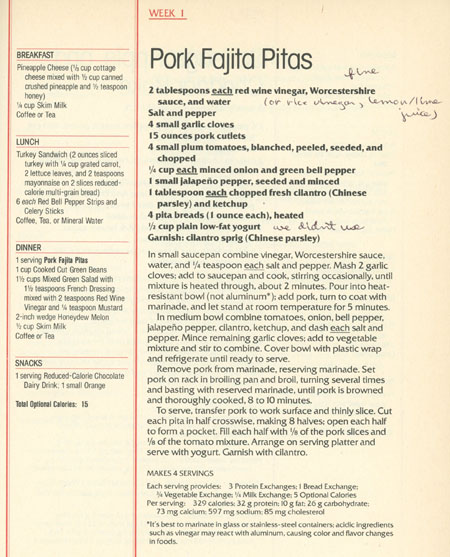

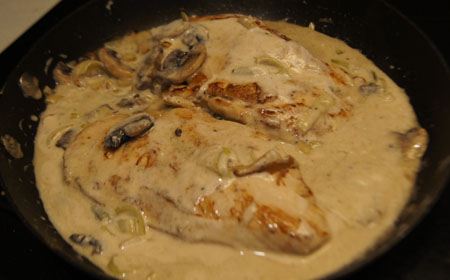 And our plated meal:
And our plated meal: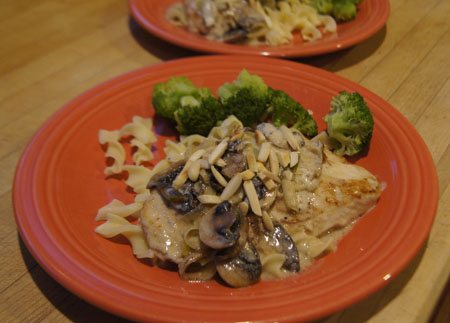
 This is the fifth and last book that I own in the Foods of the World series. Once again, I look forward to discovering another interesting author as I open Cooking of Germany, just as I discovered M. F. K. Fisher in the
This is the fifth and last book that I own in the Foods of the World series. Once again, I look forward to discovering another interesting author as I open Cooking of Germany, just as I discovered M. F. K. Fisher in the 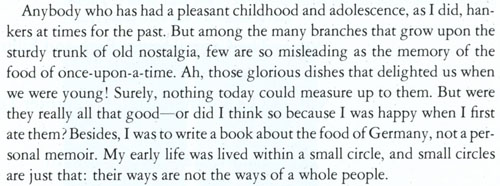

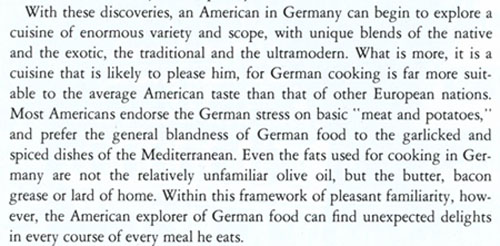 This book has wonderful full-page photographs. The photographer was German-born Ralph Crane, who worked for the NY Times as well as Time-Life books. Here is an example of the full-page photos in this book:
This book has wonderful full-page photographs. The photographer was German-born Ralph Crane, who worked for the NY Times as well as Time-Life books. Here is an example of the full-page photos in this book: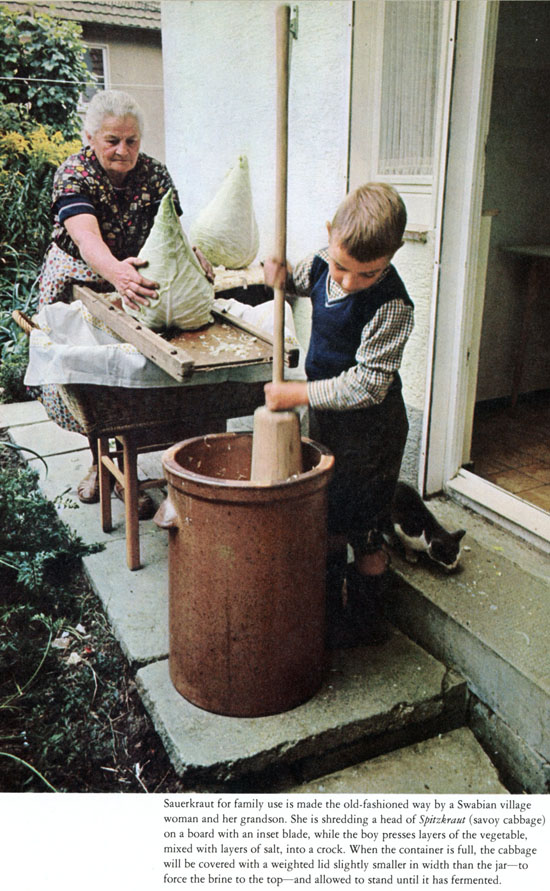
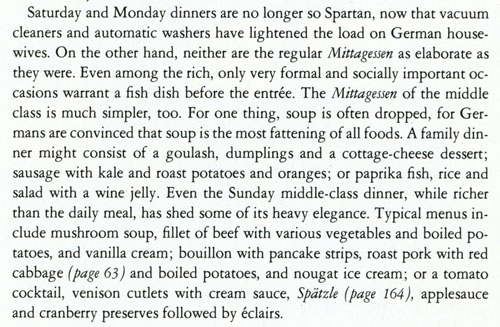
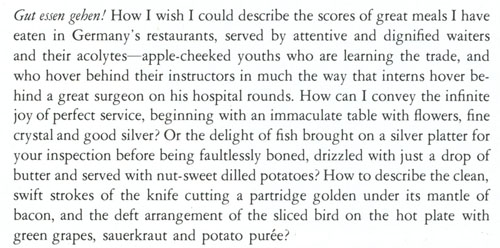
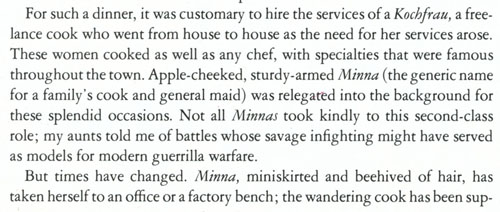

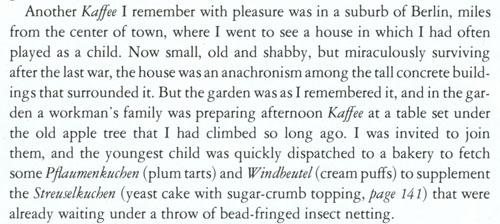 The flavor and of the Cooking of Germany continues to the end of the book. The next chapters are “A Cooking History 2,000 Years Old”, “The Northern Style: Cold-Climate Cuisine”, “The Central Style: Rich and Filling”, “The Southern Style: A lighter Touch”, “Baking Raised to a Fine Art”, and “Festive Revelry and Nostalgic Holidays”. Here are a few thoughts about these chapters.
The flavor and of the Cooking of Germany continues to the end of the book. The next chapters are “A Cooking History 2,000 Years Old”, “The Northern Style: Cold-Climate Cuisine”, “The Central Style: Rich and Filling”, “The Southern Style: A lighter Touch”, “Baking Raised to a Fine Art”, and “Festive Revelry and Nostalgic Holidays”. Here are a few thoughts about these chapters.
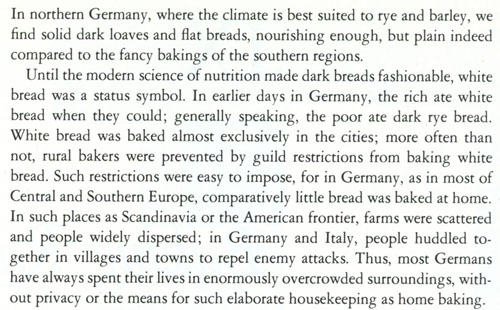

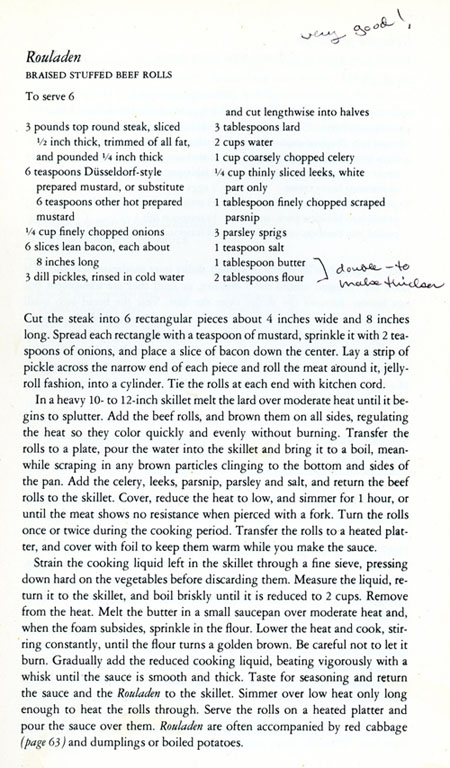 As suggested in the recipe, I’ll serve it with a little Red Cabbage with Apples.
As suggested in the recipe, I’ll serve it with a little Red Cabbage with Apples.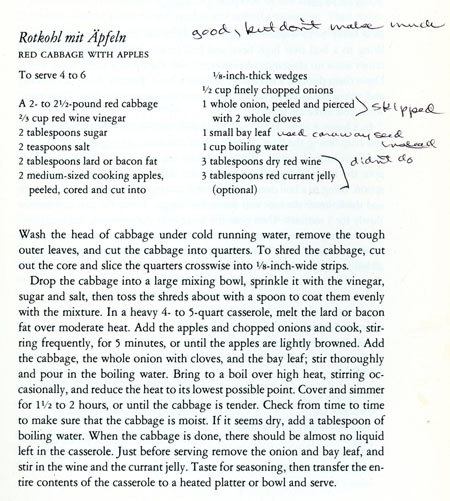


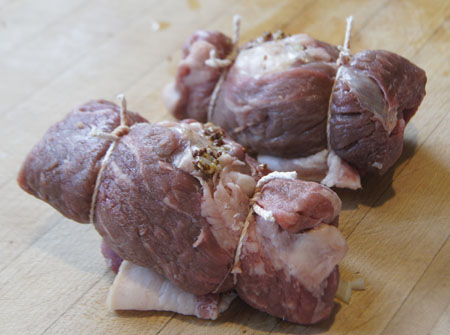 Choose a deep skillet with a heavy lid. I used my old cast-iron stewing pot; a LeCreuset or any heavy cooking pan or pot or skillet would work. Heat the skillet over moderate heat; add the lard (or butter) and heat until it begins to splutter. Add the beef rolls, and brown them on all sides, regulating the heat so they color quickly and evenly without burning. Transfer the rolls to a plate and set aside.
Choose a deep skillet with a heavy lid. I used my old cast-iron stewing pot; a LeCreuset or any heavy cooking pan or pot or skillet would work. Heat the skillet over moderate heat; add the lard (or butter) and heat until it begins to splutter. Add the beef rolls, and brown them on all sides, regulating the heat so they color quickly and evenly without burning. Transfer the rolls to a plate and set aside.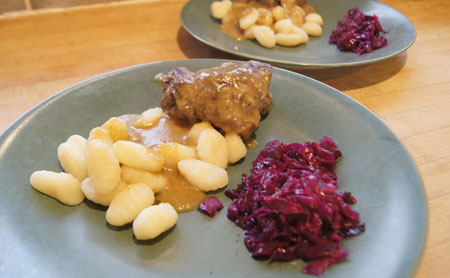 These were delicious! The gravy was amazing, thick and full of flavor. The pickle inside was fun. These remind us of one of our favorite meals, called “little piggies” by my husband’s family. It’s still about his favorite meal – strips of bacon on strips of round steak, rolled and secured with a toothpick, cooked in a skillet and served over mashed potatoes with gravy. I like the rouladen as made above with tender sirloin steak, because there is less fuss in preparation, and the de-fatted gravy isn’t greasy.
These were delicious! The gravy was amazing, thick and full of flavor. The pickle inside was fun. These remind us of one of our favorite meals, called “little piggies” by my husband’s family. It’s still about his favorite meal – strips of bacon on strips of round steak, rolled and secured with a toothpick, cooked in a skillet and served over mashed potatoes with gravy. I like the rouladen as made above with tender sirloin steak, because there is less fuss in preparation, and the de-fatted gravy isn’t greasy. A “Schlemmertopf” is a covered clay baking pot. I wrote a lot of material on clay pots in
A “Schlemmertopf” is a covered clay baking pot. I wrote a lot of material on clay pots in  And Six Golden Rules:
And Six Golden Rules: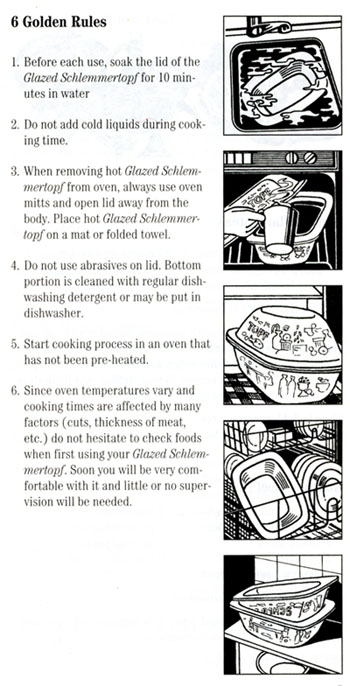 The first 23 pages of this booklet is written in English, then (as far as I can tell) the same instructions and recipes are written in Spanish and then in French. Example recipes are stuffed flank steak, beef stew, meat loaf, beef cabbage rolls, roast beef, chicken shanghai (I made this for
The first 23 pages of this booklet is written in English, then (as far as I can tell) the same instructions and recipes are written in Spanish and then in French. Example recipes are stuffed flank steak, beef stew, meat loaf, beef cabbage rolls, roast beef, chicken shanghai (I made this for 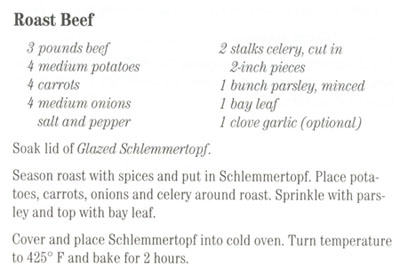 My roast is only about a pound and a half, so I will cut the recipe in half. Note how the recipe (above) does not state what cut of beef to use, nor does it tell me if the potatoes, carrots, and onions are to be peeled or chopped. It does direct the cook to cut the celery in “2-inch pieces”. I decided to peel and cut in half the potatoes, carrrots, and onions.
My roast is only about a pound and a half, so I will cut the recipe in half. Note how the recipe (above) does not state what cut of beef to use, nor does it tell me if the potatoes, carrots, and onions are to be peeled or chopped. It does direct the cook to cut the celery in “2-inch pieces”. I decided to peel and cut in half the potatoes, carrrots, and onions.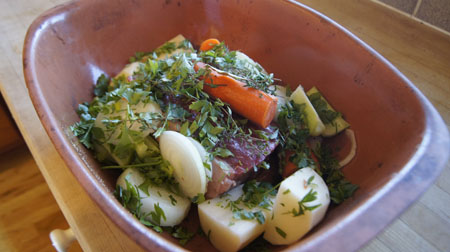
 This was good. The potatoes were nicely browned and not mushy inside. I liked the onions too – browned and soft and perfect. I wasn’t able to make a gravy, so I served it with ketchup. (I liked the
This was good. The potatoes were nicely browned and not mushy inside. I liked the onions too – browned and soft and perfect. I wasn’t able to make a gravy, so I served it with ketchup. (I liked the  This treasure is my mother’s copy of my book of the same name, as covered in my
This treasure is my mother’s copy of my book of the same name, as covered in my 
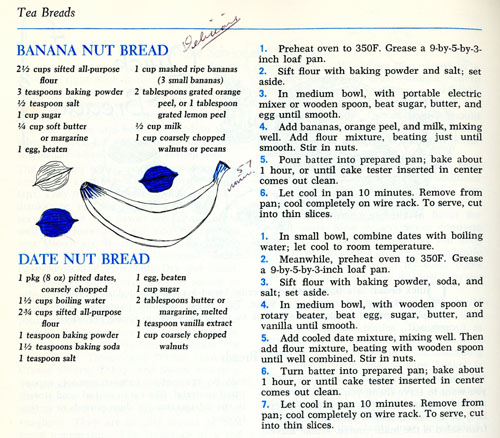 I have about 3 or 4 banana bread recipes – I rotate through different versions, but most of my recipes call for vegetable oil – this one uses butter or margarine instead. Might be interesting to try. Seems I often have ripe bananas to use up!
I have about 3 or 4 banana bread recipes – I rotate through different versions, but most of my recipes call for vegetable oil – this one uses butter or margarine instead. Might be interesting to try. Seems I often have ripe bananas to use up!
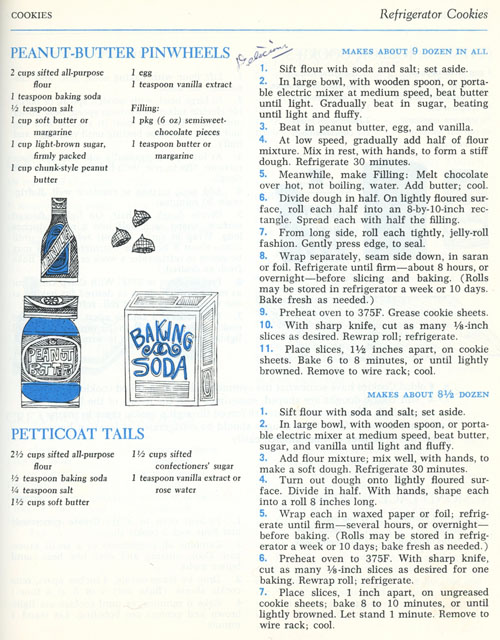 On the recipe Chili Con Carne in Red Wine, she commented it was “Pretty good, kinda runny”. I think she served it with the suggested Polenta Squares, a recipe later in the book, because she commented at the polenta squares “Good – I like it”. This makes me chuckle. I too like tomato-based sauces over polenta. I just discovered home-cooked polenta a few years ago. My dining partner sort of likes it, and I can imagine my father felt the same way. So her “Good – I like it” is a sort of rebellion. (I had no idea she ever tried a polenta dish.) She liked the deep fried Corn Fritters, but thought the Chili Con Carne only “fair”.
On the recipe Chili Con Carne in Red Wine, she commented it was “Pretty good, kinda runny”. I think she served it with the suggested Polenta Squares, a recipe later in the book, because she commented at the polenta squares “Good – I like it”. This makes me chuckle. I too like tomato-based sauces over polenta. I just discovered home-cooked polenta a few years ago. My dining partner sort of likes it, and I can imagine my father felt the same way. So her “Good – I like it” is a sort of rebellion. (I had no idea she ever tried a polenta dish.) She liked the deep fried Corn Fritters, but thought the Chili Con Carne only “fair”.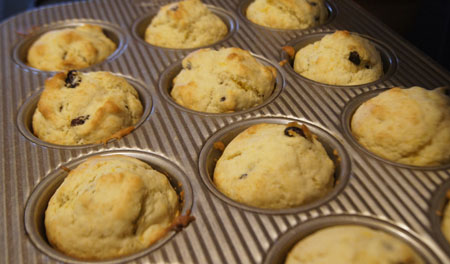 These muffins are cake-like, or cupcake-like. The muffins I make are usually packed with bananas or apples or carrots, or whole grains, so to us, they tasted “less-healthy-than-usual”. Although, after my first bite of one of these muffins, I just wanted . . . more!
These muffins are cake-like, or cupcake-like. The muffins I make are usually packed with bananas or apples or carrots, or whole grains, so to us, they tasted “less-healthy-than-usual”. Although, after my first bite of one of these muffins, I just wanted . . . more!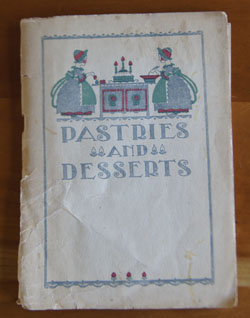 This might have belonged to my maternal grandmother. There is very little handwriting in it, but what there is looks like hers. Or it might have come from
This might have belonged to my maternal grandmother. There is very little handwriting in it, but what there is looks like hers. Or it might have come from 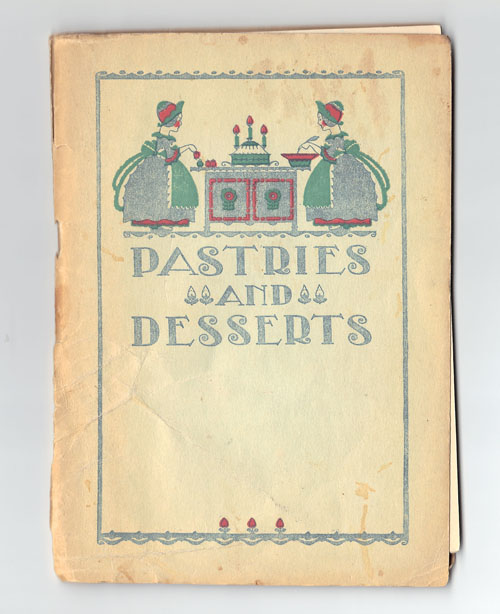
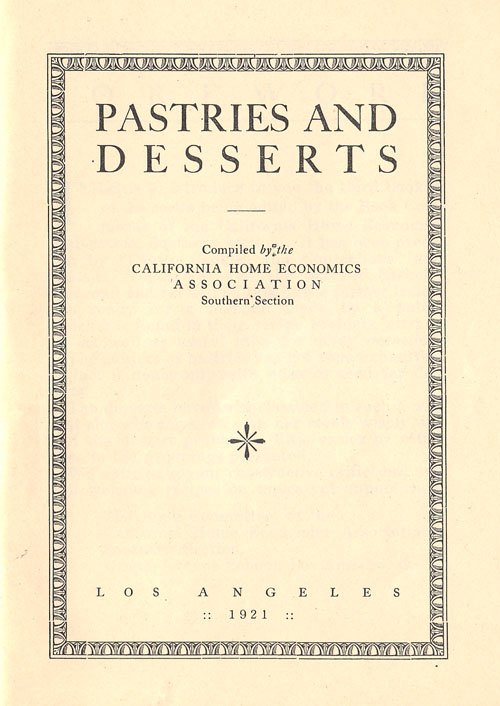
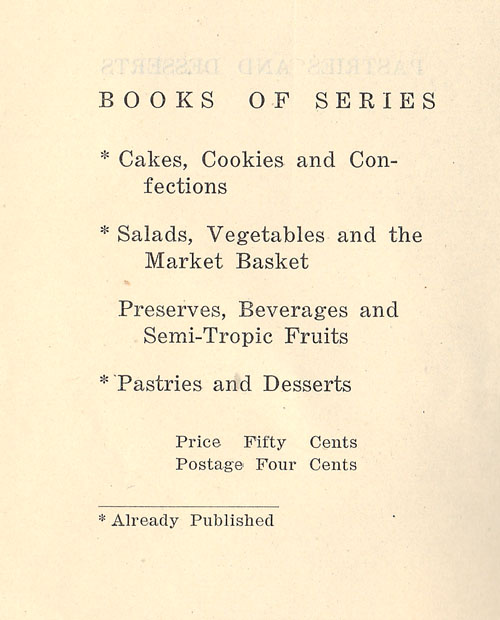 The entire content has a pleasing typeface and layout, no typos, is well-organized with cross-references, and has a very useful index at the end. The content is by the California Home Economics Association, Southern Section, but who is responsible for the printing of this 1921 cookbook? I find “Press of Clyde Browne” and “Cover Design by Stanley Edwards” on the back cover:
The entire content has a pleasing typeface and layout, no typos, is well-organized with cross-references, and has a very useful index at the end. The content is by the California Home Economics Association, Southern Section, but who is responsible for the printing of this 1921 cookbook? I find “Press of Clyde Browne” and “Cover Design by Stanley Edwards” on the back cover: Clyde Browne, was a self-identified printer, according to a
Clyde Browne, was a self-identified printer, according to a 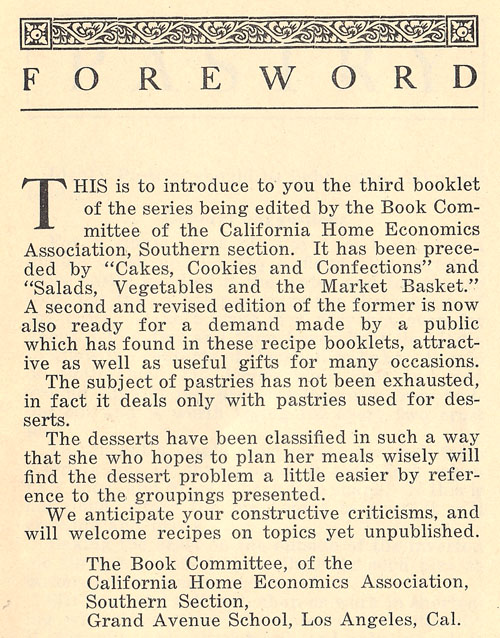 This foreword tells us that the
This foreword tells us that the 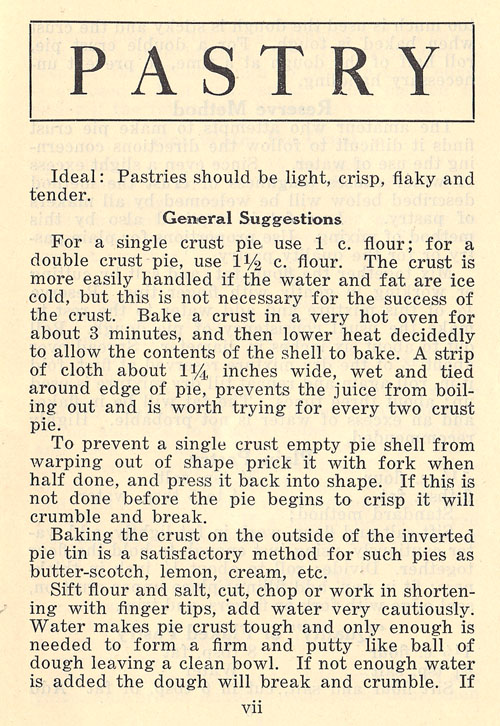
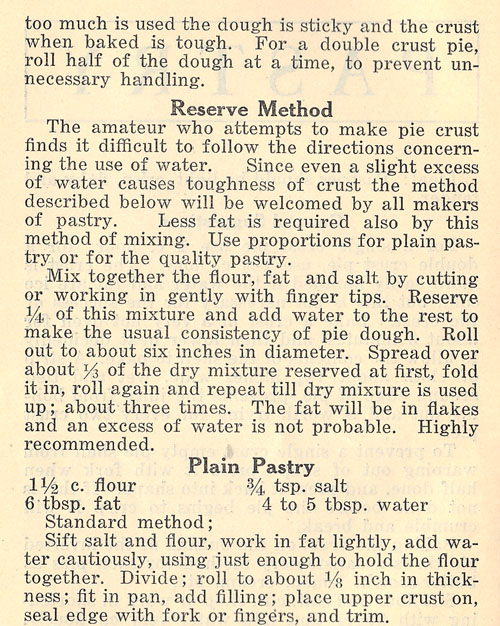 Note that besides the instruction “hot oven for 3 minutes”, no time is given for baking the crust. This is true throughout this 1921 cookbook. The baking recipes just say “cook until done”. Some of the recipes for steamed puddings have a designated cooking time, but the desserts cooked on the stove top do not.
Note that besides the instruction “hot oven for 3 minutes”, no time is given for baking the crust. This is true throughout this 1921 cookbook. The baking recipes just say “cook until done”. Some of the recipes for steamed puddings have a designated cooking time, but the desserts cooked on the stove top do not.
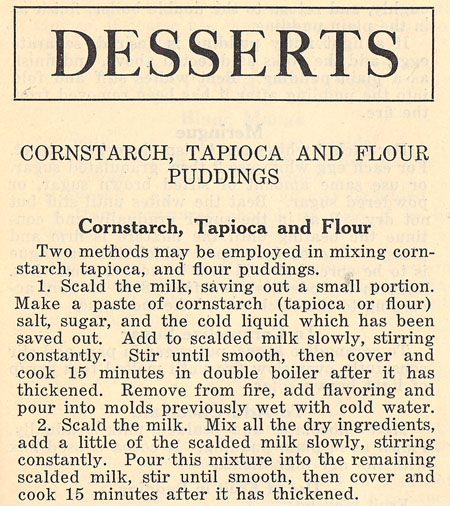
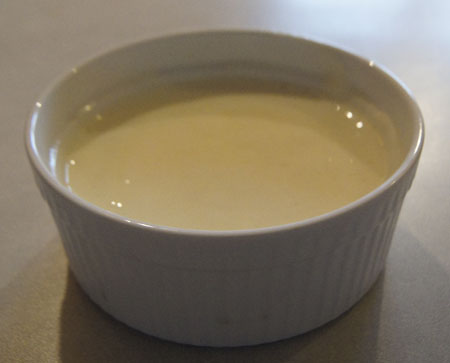 I made only three custard cups, and it served three people! It was so good – I hadn’t made it in years and it’s a comfort food to me. I put some sliced strawberries on top and served it with cookies. My grandson liked to dip those cookies in the pudding!
I made only three custard cups, and it served three people! It was so good – I hadn’t made it in years and it’s a comfort food to me. I put some sliced strawberries on top and served it with cookies. My grandson liked to dip those cookies in the pudding!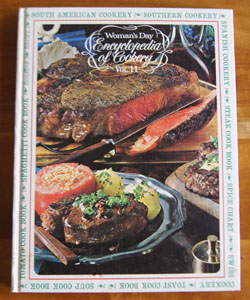
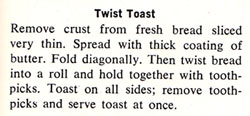 Sour Cream in its simplest form is “unpasteurized heavy sweet cream that has been allowed to stand in a warm place until it has become sour”. Commercial sour cream is made from “sweet cream chemically treated with lactic-acid bacteria to produce a thick cream with a mild tangy flavor”. The South American Cook Book begins with an interesting essay by Jean Gormaz on the widely varied cooking of this continent of many climates. Vatapa, a fish stew from Brazil, illustrates the variety of ingredients in South American cookery.
Sour Cream in its simplest form is “unpasteurized heavy sweet cream that has been allowed to stand in a warm place until it has become sour”. Commercial sour cream is made from “sweet cream chemically treated with lactic-acid bacteria to produce a thick cream with a mild tangy flavor”. The South American Cook Book begins with an interesting essay by Jean Gormaz on the widely varied cooking of this continent of many climates. Vatapa, a fish stew from Brazil, illustrates the variety of ingredients in South American cookery.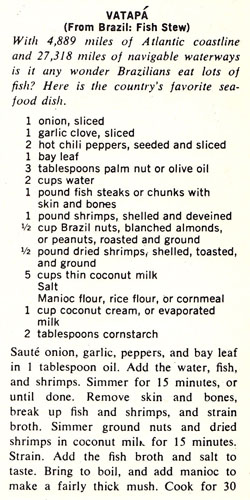
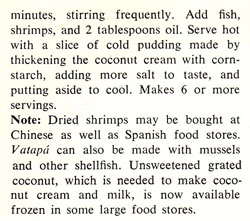 Cook books called Southeast Asian Cookery, Southern Cookery, and Southwest Cookery follow each other with no short entries between. (This volume of the Encyclopedia of Cookery sure has a lot of cook books in it.) The Southwestern cook book includes few dishes familiar to me, except chili sauce, tacos, and sopapillas. Carne Adobada is an example of a recipe I have never heard of before, and it takes days to make.
Cook books called Southeast Asian Cookery, Southern Cookery, and Southwest Cookery follow each other with no short entries between. (This volume of the Encyclopedia of Cookery sure has a lot of cook books in it.) The Southwestern cook book includes few dishes familiar to me, except chili sauce, tacos, and sopapillas. Carne Adobada is an example of a recipe I have never heard of before, and it takes days to make.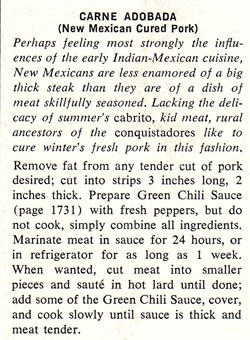

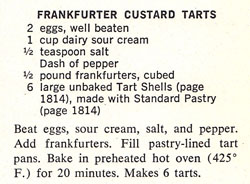 I would never make these, they do not sound tasty to me. And “taste” is an entry: “one of the senses of man”. Tea is honored with an essay by James Beard on “the pleasures of tea drinking”, and I like his era “B. T.” – before tea:
I would never make these, they do not sound tasty to me. And “taste” is an entry: “one of the senses of man”. Tea is honored with an essay by James Beard on “the pleasures of tea drinking”, and I like his era “B. T.” – before tea: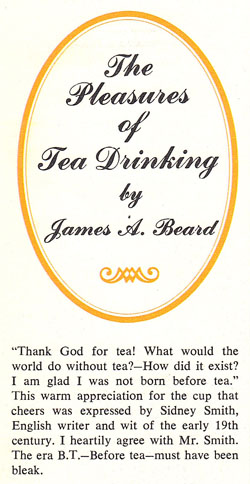 Tetrazzini is a dish I discussed in
Tetrazzini is a dish I discussed in 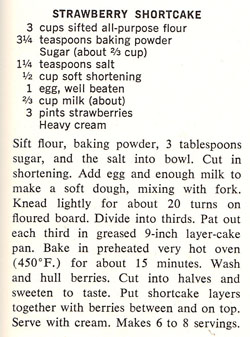 Why did I choose this recipe? I have been making strawberry shortcake for years. But I have always started with my mother’s basic biscuit recipe, and just added “a bit” of sugar. This is an actual “shortcake” recipe. Plus, I like the way the dough is rolled out into a big circle and baked in a cake pan. Saves a step in cutting out the biscuits. And finally, I had some strawberries in the refrigerator looking to be used!
Why did I choose this recipe? I have been making strawberry shortcake for years. But I have always started with my mother’s basic biscuit recipe, and just added “a bit” of sugar. This is an actual “shortcake” recipe. Plus, I like the way the dough is rolled out into a big circle and baked in a cake pan. Saves a step in cutting out the biscuits. And finally, I had some strawberries in the refrigerator looking to be used! Meanwhile, slice the strawberries and add a tablespoon or so of sugar. Stir and allow to macerate until you serve the shortcake.
Meanwhile, slice the strawberries and add a tablespoon or so of sugar. Stir and allow to macerate until you serve the shortcake. This was excellent! I like the egg in the dough, and I like rolling it into one circle instead of biscuits. My dining partner said “yum, but not enough!” I take that as a thumbs up.
This was excellent! I like the egg in the dough, and I like rolling it into one circle instead of biscuits. My dining partner said “yum, but not enough!” I take that as a thumbs up.